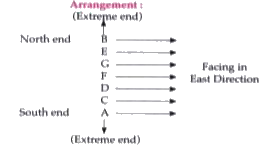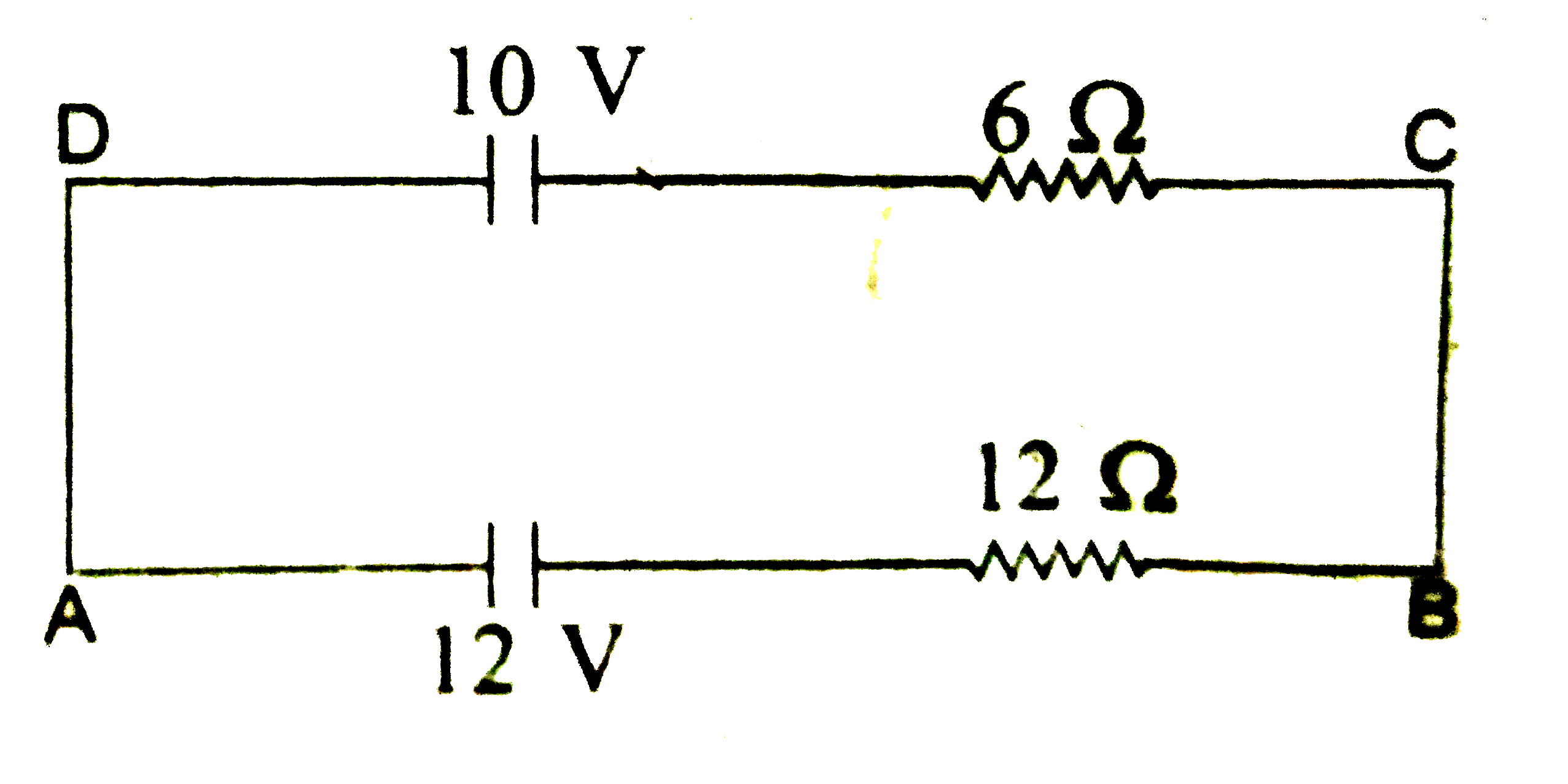Study the given information carefully and answer the questions that follow:
(i) A, B, C, D, E, F and G are sitting on a wall and all of them are facing east.
(ii) C is on the immediate right of D.
(iii) B is at an extreme end and has E as his neighbour.
(iv) G is between E and F.
(v) D is sitting third from the south end.
Name the person who should change place with C such that he gets the third place from the north end.
E
F
G
D
The correct Answer is:C
By analysing the given information, we get
From (ii)
C ⇒ Immediate right of D.
From (iii)
B⇒ Extreme end from north.
From (v)
D⇒ Third from south end.
From (iv)
G⇒ Between E and F.
From (iii)
E⇒ Neighbour of B
Arrangement :

Third from the north end ⇒ G. Therefore, G should change place with C.
Topper's Solved these Questions
- BOOK - LUCENT PUBLICATIONCHAPTER - PROBLEM SOLVING (PUZZLES & SEATING ARRANGEMENT)EXERCISE - Exercise-476videos
PROBLEM SOLVING (PUZZLES & SEATING ARRANGEMENT)
- BOOK - LUCENT PUBLICATIONCHAPTER - PROBLEM SOLVING (PUZZLES & SEATING ARRANGEMENT)EXERCISE - Exercise-554videos
PROBLEM SOLVING (PUZZLES & SEATING ARRANGEMENT)
- BOOK - LUCENT PUBLICATIONCHAPTER - PROBLEM SOLVING (PUZZLES & SEATING ARRANGEMENT)EXERCISE - Exercise-247videos
PROBLEM SOLVING (PUZZLES & SEATING ARRANGEMENT)
- BOOK - LUCENT PUBLICATIONCHAPTER - PASSAGE AND CONCLUSION EXERCISE - Exercise - 345videos
PASSAGE AND CONCLUSION
- BOOK - LUCENT PUBLICATIONCHAPTER - ROWS AND RANKSEXERCISE - Exercise (Type-IV : Miscellaneous)2videos
ROWS AND RANKS
Similar Questions
Directions: Study the following information carefully and answer the question given below: A, B, C, D, E, F, G and H are sitting around a circle facing the centre. B is third to the right of F and third to the left of H. C is fourth to the left of A, who is not an immediate neighbour of F or B. E is not an immediate neighbour of B. G is second to the right of D.
Who is to the immediate left of B
1) D
2) G
3) D or G
4) Data inadequate
5) None of these02:43View SolutionRead the information given below and answer the questions that follow :
(i) In a family of six persons A, B, C, D, E and F, there are two married couples.
(ii) D is grandmother of A and mother of B.
(iii) C is wife of B and mother of F.
(iv) F is the grand daughter of E.
What is C to A ?02:26View SolutionStudy the following information carefully and answer the questions given below it.
Six lectures-A, B, C, D, E and F - are to be delivered from Monday to Sunday, one lecture every day.
(i) Lecture C cannot be delivered on Friday.
(ii) Lecture A is delivered immediately after lecture D.
(iii) There should be a gap of two days between the lectures B and F.
(iv) There is one holiday except Saturday. Lecture F is delivered on the next day of holiday.
(v) Lecture E is delivered on Wednesday and it is not immediately followed by lecture F.
On which day was lecture D delivered ?04:17View SolutionThe interest rates in the institutional market have come down significantly and at present are in the range of 5.25 to 5.75 percent per annum. However, interest rates on small savings schemes such as the Post Office Saving Schemes, RBI Relief Bonds, Provident Fund and PPF continue to be administered at high levels in relation to market rates. These schemes also have a variety of tax incentives, which result in much higher post-tax returns and on the flip side more liability for the government. It is ironic that it is predominantly the urban population (and more often people in the high tax bracket), which is benefiting from high rates and tax benefits. The size of small savings has assumed a significant proportion of financial saving in the country. This has also increased dramatically the debt service burden of both Central and State Governments.
The interest rates on small savings have decreased considerably during the last few years.02:51View SolutionIn a shop, the items are arranged in a shelf consisting of six rows. Biscuits are kept above the tins of chocolates but below the rows of packets of chips, cakes are at the bottom and the bottles of peppermints are below the chocolates. The topmost row had the display of jam bottles. where exactly are the bottles of peppermints? Mention the place from the top.
07:54View Solutionदिए गये विघुत परिपथ की सहायता से ज्ञात कीजिए
- (i) परिपथ में धारा , तथा
(ii) बिन्दु A तथा B के बीच विभवान्तर ।
 03:03View Solution
03:03View Solutionएक छात्र को A,B,C या D ग्रेड मिलने की सम्भावना है। प्रायिकता ज्ञात कीजिये कि कम से कम B ग्रेड प्राप्त कर सके, जबकि A ग्रेड प्राप्त करने की प्रायिकता : 20,B ग्रेड प्राप् करने की प्रायिकता 40,C ग्रेड प्राप्त करने की प्रायिकता- 30,D ग्रेड प्राप्त करने की प्रायिकता 10 है।
04:34View Solutionयदि 10 टिकटों पर 1 से 10 तक की (प्रत्येक पर एक) संख्यायें लिखी हुई हैं। कोई संख्या दोहराई नहीं गई है। यदि A एक ऐसी घटना है, जिसमें विषम संख्यायें हों और B एक ऐसी घटना हो, जिसमें 3 से विभाज्य संख्या हों, तो दिखाओ कि P(A∪B)=P(A)+P(B)−P(A∪B)
04:23View Solutionएक पासा फेंका जाता है। मान लीजिए घटना E ‘पासे पर संख्या 4 दर्शाता है और घटना F 'पासे पर सम संख्या दर्शाता है। क्या E और F परस्पर अपवर्जी हैं ?
13:00View Solutionतीन तत्व A, B और C एक घनीय ठोस जलक में क्रिस्टलीकृत होते हैं । परमाणु A कोनो पर परमाणु B घन के केंद्र पर तथा परमाणु C किनारो पर स्थित होते हैं । यौगिक का सूत्र होगा :
04:44View Solution100 g fcc क्रिस्टल जिसका घनत्व d=10g/cm3 है तथा कोर 100 pm के बराबर है, में परमाणुओं की संख्या होगी :
03:15View Solutionरासायनिक अभिक्रियाओं के आधार पर निम्नलिखित धातुओं की विधुत - रासायनिक श्रेणी का निर्माण करो ।
(i) A+H2SO4→ASO4+H2
(ii) C+ACl2→CCl2+A
(iii) C+ECl2→ अभिक्रिया नहीं होती
(iv) D+2BCl→DCl2+2B
(v) D+H2SO4→ अभिक्रिया नहीं होती |01:21View Solutionनिम्नलिखित समीकरणों के अनुसार धातु A,B,C,D व H2 की विधुत - रासायनिक श्रेणी का निर्माण करो ।
(i) 2A+2HCl→2ACl+H2
(ii) B+2HCl→BCl2+H2
(iii) 2A+BCl2→2ACl+B
(iv) D+CCl2→DCl2+C
(v) D+HCl→ कोई अभिक्रिया नहीं03:27View Solutionकुछ तत्वों के E∘ नीचे दिए गए है ।
I2+2e→2I− E∘=0.54V
MnO2−4+8H++5e→Mn2++4H2O, E∘=1.52V
Fe3++e→Fe2+ E∘=0.77V
Sn4++2e→Sn2+ E∘=0.14V
ज्ञात करो |
(a) सबसे प्रबल अपचायक व दुर्बल ऑक्सीकारक
(b) सबसे दुर्बल अपचायक व प्रबल ऑक्सीकारक
(c ) उपरोक्त मानो के आधार पर निम्न में से कौन - सी अभिक्रियाएँ स्वतः हो जायेंगी ?
(i) Sn4++2Fe2+→Sn2++2Fe3+
(ii) 2Fe2++I2→2Fe3++2I−
(iii) Sn4++2I−→Sn2++I2
(iv) SN2++I2→Sn4++2I−View Solutionपांच तत्व A, B, C, D व E के E∘ क्रमशः −1.36,+0.32,+1.36,−0.42 तथा −2.2.6 है उनको बढ़ती सक्रियता के क्रम में लिखो ।
00:51View Solutionनीचे कुछ अभिक्रियाएँ दी गयी है-
(a) ACl2+B→BCl2+A
(b) B+DCl→ कोई अभिक्रिया नहीं
(c) C+2DCl→2D+CCl2
(d) C+ECl2→ कोई अभिक्रिया नहीं
(e) H2+ECl2→2HCl+E
(f) H2+FCl2→ कोई अभिक्रिया नहीं
उपरोक्त दिए तत्वों (A से F) को रासायनिक सक्रियता के घटते क्रम में व्यवस्थित करो ।02:34View Solution

